Essential Care Techniques for Your Home's Hot Water SystemTips on How to Keep Your Home's Hot Water System in Good Condition
Click HereDo you find yourself in search of additional info concerning How to Maintain a Hot Water Heater in a Few Simple Steps?

Hot water is essential for day-to-day convenience, whether it's for a refreshing shower or cleaning meals. To ensure your hot water system runs effectively and lasts longer, regular maintenance is essential. This write-up gives useful tips and understandings on exactly how to preserve your home's hot water system to stay clear of disruptions and pricey repair work.
Introduction
Keeping your home's hot water system could seem difficult, but with a couple of easy actions, you can guarantee it runs smoothly for years ahead. This overview covers everything from recognizing your hot water system to DIY upkeep tips and recognizing when to contact specialist help.
Value of Maintaining Your Hot Water System
Normal maintenance not just extends the lifespan of your warm water system but likewise ensures it runs efficiently. Disregarding maintenance can result in lowered effectiveness, greater energy bills, and also early failing of the system.
Indications Your Hot Water System Requirements Upkeep
Knowing when your warm water system needs focus can stop major problems. Look out for indicators such as inconsistent water temperature level, odd noises from the heating system, or rusty water.
Recognizing Your Hot Water System
Prior to diving into upkeep jobs, it's helpful to comprehend the fundamental parts of your warm water system. Usually, this consists of the water heater itself, pipelines, anode poles, and temperature level controls.
Monthly Maintenance Tasks
Routine month-to-month checks can assist capture small problems before they intensify.
Purging the Water Heater
Flushing your hot water heater gets rid of sediment accumulation, enhancing effectiveness and extending its life.
Monitoring and Changing Anode Rods
Anode poles protect against corrosion inside the storage tank. Evaluating and changing them when worn out is important.
Checking and Changing Temperature Level Setups
Readjusting the temperature settings ensures ideal efficiency and safety.
DIY Tips for Maintenance
You can carry out a number of upkeep tasks yourself to keep your hot water system in top problem.
Looking for Leakages
Routinely examine pipelines and links for leakages, as these can result in water damage and greater costs.
Checking Pressure Relief Valves
Evaluating the stress relief valve ensures it functions properly and avoids extreme stress buildup.
Insulating Pipes
Shielding hot water pipelines minimizes warm loss and can save energy.
When to Call a Professional
While do it yourself maintenance is useful, some problems need specialist expertise.
Complicated Problems Needing Professional Help
Examples consist of major leakages, electrical problems, or if your water heater is regularly underperforming.
Regular Professional Maintenance Advantages
Specialist maintenance can consist of comprehensive assessments, tune-ups, and making certain conformity with safety and security criteria.
Final thought
Normal maintenance of your home's hot water system is vital for effectiveness, durability, and expense savings. By following these pointers and recognizing when to look for expert help, you can ensure a trusted supply of warm water without unexpected disruptions.
How to Maintain an Instant Hot Water Heater
Before tinkering with your hot water heater, make sure that it’s not powered on. You also have to turn off the main circuit breaker and shut off the main gas line to prevent accidents. Also turn off the water valves connected to your unit to prevent water from flowing into and out of the appliance. 2. When you’re done, you have to detach the purge valves’ caps. These look like the letter “T” and are situated on either side of the water valves. Doing so will release any pressure that has accumulated inside the valves while at the same time avoid hot water from shooting out and burning your skin. 3. When the purge valves’ caps are removed, you have to connect your hosing lines to the valves. Your unit should have come with three hoses but if it didn’t, you can purchase these things from any hardware or home repair shops. You can also get them from retail stores that sell water heating systems. Read the user’s manual and follow it to complete this task properly. When the hosing lines are connected, open the purge port’s valves. 4. You should never use harsh chemical cleaners or solutions when cleaning your unit. Make use of white vinegar instead. It should be undiluted and you’ll probably use about 2 gallons. 5. Now flush your water heater. This task should probably take about 40 minutes. We can’t give you specific directions for this because the procedure is carried out depending on the type, model and brand of your heater. With that being said, refer to the user’s manual. 6. When you’re done draining the unit, you have to turn off the purge port valves again. Remove the hosing lines that you earlier installed on each of the water valves. Put the valve caps (purge port) back in their respective places and be very careful so as not to damage the rubber discs that are found inside these caps. 7. Now that everything’s back in place, check your user’s manual again to find out how to reactivate your water heating system. 8. Once it is working, turn one of your hot water faucets on just to let air pass through the heater’s water supply pipes. Leave the tap on until water flows smoothly out of it. https://www.orrplumbing.com/blog/2014/september/how-to-maintain-an-instant-hot-water-heater/

We are very involved in Tips on Maintaining a Water Heater and I really hope you appreciated our article. Be sure to pause to promote this blog posting if you enjoyed reading it. I am grateful for your time. Kindly visit our blog back soon.
Additional Resources